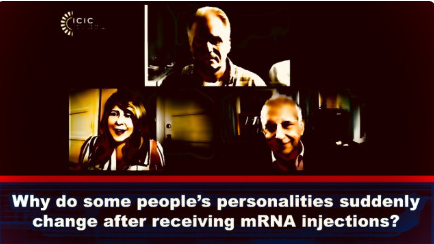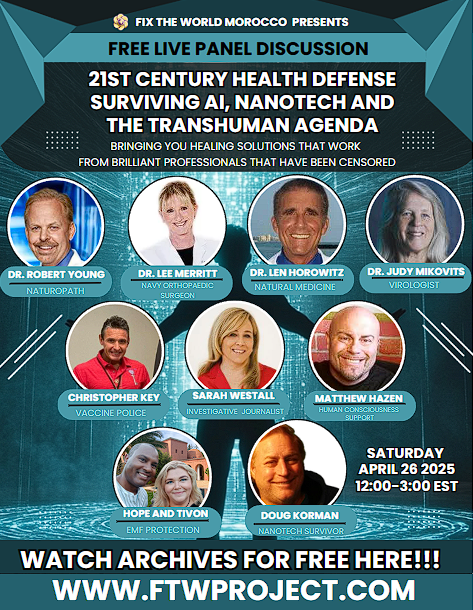A couple of days ago we published an article about a study, an experiment really, where CRISPR-Cas9, a gene-editing tool, was used to manipulate behaviour in hamsters. Contrary to what the researchers were hoping, the experiment “developed” vicious hamster monsters that turned on littermates of the same sex.
In our previous article we asked the question: would they do this in humans? And now we ask: could they, in other words, do they have the ability to modify human behaviour through genetic re-engineering?
Keep these questions in mind as you read, and watch, the following.
Klaus Schwab’s Genetic Modification
The clip below is an excerpt from a 16-minute interview by Charlie Rose on 13 November 2013.
Rose asked Klaus Schwab: “You want to talk about in this year’s [Davos] conference, in January, mastering the fourth industrial revolution.”
Schwab responded: “If you look into the future, there’s so much going on in technology. It’s a real revolution … Our life, the pattern of governing societies, will be so much affected with what’s going on in research in innovation … look at big data …”
Rose: “And look at things like artificial intelligence and robots. Look at things like gene editing, opening a whole new horizon for medical science”
Schwab: “You see the difference of this fourth industrial revolution is it doesn’t change what you are doing. It changes you, if you take a genetic editing, just as an example. It’s you who are changing. And of course, this has a big impact on your identity.”
Read more: Pfizer/BioNTech mRNA Incorporates into Human DNA In as Little as Six Hours, A New Study Finds
World Economic Forum’s Genetic Modification
When Chinese researchers first edited the genes of a human embryo in a lab dish, using CRISPR, in 2015, it sparked global outcry and pleas from scientists not to make a baby using the technology, wrote MIT Technology Review in November 2018.
By the time MIT Technology Review had written its article, it may have already been happening. According to Chinese medical documents posted online in November 2018, a team at the Southern University of Science and Technology, in Shenzhen, had been recruiting couples to create the first gene-edited babies. They planned to eliminate a gene called CCR5 in hopes of rendering the offspring resistant to HIV, smallpox, and cholera.
When we attempted to retrieve the source documents MIT Technology Review linked in their article, HERE and HERE, one had been withdrawn from the Chinese Clinical Trial Registry and the other is now a dead link.
Lest it should suffer the same fate as the other, we have downloaded a copy of the withdrawn paper from the Chinese Clinical Trial Registry – ‘Evaluation of the safety and efficacy of gene editing with human embryo CCR5 gene’, Southern University of Science and Technology, 8 November 2018 – and attached it below to preserve it.
After the baby in China that had been genetically modified using CRISPR technology made headlines globally, the WEF raised the topic of ethical guidelines and safety standards they, with their globalist technocratic ideology, would want to establish globally. Why WEF thinks the public would trust their ethics and standards is beyond comprehension but the discussion touches on some points that confirm how far genetic engineering had gone as far as the panellists were aware.
The discussion panel, moderated by Oliver Cann, consisted of Victor Dzau and Jodi Halpern. As Dzau mentioned at the outset, the discussion was limited to CRISPR but there are other “genetic techniques.”
“[CRISPR] is being able to precisely molecular scissor, take out his specific sequence. And now we can even do in single bases. And possibly even replace it … You can apply it in somatic therapy and germline … where the controversy is, is around the germline,” Dzau said. Manipulating embryos or germlines changes generational genetic component makeup and “so the offspring are therefore altered, probably indefinitely, in terms of a genetic makeup.”
Somatic therapy is treating diseases relating to somatic cells which, in biology, are all living matter except the reproductive, or germ, cells. Somatic therapy treats diseases in adults. Germline gene therapy or engineering aims to place corrected cells inside the germline (e.g., cells of the ovary or testis), it is used to “treat” diseases in the embryo.
“With human germline engineering, we are beginning to seize control of our own evolution, yet we have barely begun to grapple with the consequences.”
Engineering the Human Germline: An Exploration of the Science and Ethics of Altering the Genes We Pass to Our Children, Gregory Stock & John Campbell, 3 February 2000
At timestamp 13:29, a reporter from the New York Times asked a question regarding recent experiments where Chinese researchers had cloned 5 monkeys for which they removed certain genes with the intent to cause serious mental illness. The question and therefore the answer was framed around the ethics of experimenting on animals in this way. However, in his answer Dzau raised the ethics of other experiments being done:
“There is research now being done on human brain cells implanted into animals where now the concern is you can have human conscious this hybrid research, chimaera research. Right? So, this is a whole field of ethicsargument that needs to be vetted a lot more thorough than we are today.”
At the end of the video, Cann gave the results of a survey which asked the question: does technology produce more “good” than “harm” in society? Of the 10,000 respondents, 53% said they believed that technology was responsible for more harm than good. In other words, a small majority, 53%, in 2019 thought technology causes harm. It would be interesting to see what the results of such a survey would be today.
The World Health Organisation’s Genetic Modification
CRISPR-Cas9 and other genome editing tools present researchers with a double-edged capacity to produce great medical advancements and grave harm. Given the promise and perils associated with this powerful new technology, is the global governance of human genome editing desirable? Is it possible?
In March 2021, the World Health Organisation (“WHO”) convened an expert advisory committee on developing global standards for governance and oversight of human genome editing, including somatic as well as germline and heritable approaches. Once again, with their globalist technocratic ideology, why WHO thinks the public would trust their ethics and standards is beyond comprehension
In the video below, Dr. Robin Lovell-Badge, who served on this WHO committee, and Dr. Hyun discussed the methods of genome editing, applications and “technical problems,” as well as the scientific, ethical, and policy considerations raised by efforts to successfully implement oversight and governance.
Dr. Lovell-Badge’s presentation is technical but there are some concepts which have become familiar to most who have taken an interest in what the experimental gene therapy injections, often referred to as Covid vaccines, contain and do.
One familiar concept is at timestamp 17:07, Dr. Lovell-Badge explained somatic gene therapy, below are slides relating to this section of his presentation.


Another concept that people may be starting to become familiar with from the “Covid era” is Dr. Lovell-Badges’s explanation of the slide below in regards to gene editing and the role the liver plays.

Beginning at timestamp 22:41 he explained:
“… more recent papers on muscle in mice …if you scale up the amount of virus that you have to introduce from a mouse to that you need for a human, you’d be introducing levels that were really very toxic. And so, there needs to be much more efficient ways of introducing the gene limiting components. Now when you take something like the liver, it turns out that this is much easier. So, the liver will take up things fromthe bloodstream and for example, it will take up these lipid nanoparticles whichyou can use to encapsulate messenger RNA for Cas9 protein analysis …
“… there’re some issues here, of course, if you’re doing a vivo genome editing. You’ve got to know really where everything’s going. So, in this case, you hope it’s targeting the liver. It probably doesn’t matter if it targets other cell types in the body, at least you hope it doesn’t. Except you have to be very careful that it’s not going to target germ cells because then you might inadvertently have a situation where you’ve got inheritable genome editing, of a sort, that you wouldn’t want to have because probably embryos mutant in this gene wouldn’t develop very well.”
You can watch Dr. Lovell-Badge’s full presentation in the video below.
20 September 2021 (90 mins)
Source Link: https://expose-news.com/2022/06/06/what-klaus-schwab-wef-who-and-engineering/
Bitchute: https://www.bitchute.com/channel/YBM3rvf5ydDM/
Telegram: https://t.me/Hopegirl587
EMF Protection Products: www.ftwproject.com
QEG Clean Energy Academy: www.cleanenergyacademy.com
Forbidden Tech Book: www.forbiddentech.website













